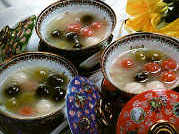
| Besides entertainment and beautiful lanterns, another important part of the Lantern Festival is eating Yuanxiao, as Latten Festival is also called as “Yuanxiao Festival”. It is also called “Tangyuan”, which has the same pronunciation as “Tuanyuan”, meaning reunion. People thus eat them to denote union, harmony and happiness for the family. It is said that the custom of eating Yuanxiao was originally from the Eastern Jin Dynasty in the 4th century. It then became popular during the Tang and Song periods. |
Yuanxiao is a kind of small dumpling balls made of glutinous rice flour. The fillings inside the Yuanxiao are either sweet or salty. Sweet fillings are made of sugar, Walnuts, sesame, osmanthus flowers, rose petals, sweetened tangerine peel, bean paste, or jujube paste. The salty variety is filled with minced meat, vegetables or a mixture. A single ingredient or any combination can be used as the filling.
The way to make Yuanxiao also varies between northern and southern China. The usual method followed in southern provinces is to shape the dough of rice flour into balls, make a hole, insert the filling, then close the hole and smooth out the dumpling by rolling it between your hands. In northern China, sweet or nonmeat stuffing is the usual ingredient. The fillings are pressed into hardened cores, dipped slightly in water and rolled in a flat basket containing dry glutinous rice flour. A layer of the flour sticks to the filling, which is then again dipped in water and rolled a second time in the rice flour. And so it goes, like rolling a snowball, until the dumpling is the desired size. Yuanxiao can be boiled, fried or steamed.
The custom of eating Yuanxiao dumplings remains today, and it encourages both old and new stores to promote their Yuanxiao products. Most restaurants try their best to improve the taste and quality of the dumplings to attract more customers. |